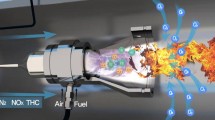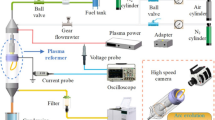Abstract
The design of efficient plasma reformers requires both efficient fuel conversion of fuel and chemical energy extraction. In this regard, liquid fuels provide the advantages of high gravimetric and volumetric energy densities, therefore yielding high energy; in particular, diesel is promising for use in plasma reformers. In this study, we investigated the ignition process in a diesel reformer driven by a rotating gliding arc using a high-speed camera. The locations of the flame kernel generated by the arc were clearly identified under different power conditions. At high power, the flame kernel was generated at the nozzle tip, which grew into a fully developed flame. This indicates that the period for fuel vaporization and mixing with air (which is a necessary step prior to chemical reactions and is typically longer than the characteristic chemical reaction time) is extremely short. Moreover, with low oxygen concentrations, we observed a rotating flame kernel. At low power, the flame kernel was generated at a distance from the nozzle tip and the arc. This result indicates that the generation mechanism of the flame kernel in the plasma reformer is not straightforward; flow and arc dynamics also influence the interactions between the arc and fuel droplets.











Similar content being viewed by others
References
Czernichowski A (1994) Gliding arc. Applications to engineering and environment control. Pure Appl Chem 66:1301–1310. https://doi.org/10.1351/pac199466061301
Bromberg L, Cohn DR, Rabinovich A et al (1998) Plasma reforming of methane. Energy Fuels 12:11–18. https://doi.org/10.1021/ef9701091
Cormier JM, Rusu I (2001) Syngas production via methane steam reforming with oxygen: Plasma reactors versus chemical reactors. J Phys D Appl Phys 34:2798–2803. https://doi.org/10.1088/0022-3727/34/18/313
Lesueur H, Czernichowski A, Chapelle J (1994) Electrically assisted partial oxidation of methane. Int J Hydrogen Energy 19:139–144. https://doi.org/10.1016/0360-3199(94)90118-X
Petitpas G, Rollier JD, Darmon A et al (2007) A comparative study of non-thermal plasma assisted reforming technologies. Int J Hydrogen Energy 32:2848–2867. https://doi.org/10.1016/j.ijhydene.2007.03.026
Dinh DK, Lee DH, Iqbal M et al (2020) Evaluation of the Thermal Effect of Arc Plasma in the Plasma-Driven Partial Oxidation of Octane. Plasma Chem Plasma Process 40:483–497. https://doi.org/10.1007/s11090-019-10054-1
Bromberg L, Cohn DR, Rabinovich A, Heywood J (2001) Emissions reductions using hydrogen from plasmatron fuel converters. Int J Hydrogen Energy 26:1115–1121. https://doi.org/10.1016/S0360-3199(01)00049-0
Lee DH, Lee JO, Kim KT et al (2011) Characteristics of plasma-assisted hydrocarbon SCR system. Int J Hydrogen Energy 36:11718–11726. https://doi.org/10.1016/j.ijhydene.2011.04.165
Pyun SH, Lee DH, Kim KT, Song YH (2016) Application of Plasma Fuel Reformer to an On-Board Diesel Burner. Plasma Chem Plasma Process 36:329–340. https://doi.org/10.1007/s11090-015-9672-3
Lee DH, Kim KT, Kang HS et al (2013) Plasma-assisted combustion technology for NOx reduction in industrial burners. Environ Sci Technol 47:10964–10970. https://doi.org/10.1021/es401513t
Bromberg L, Cohn DR, Rabinovich A (1997) Plasma reformer-fuel cell system for decentralized power applications. Int J Hydrogen Energy 22:83–94. https://doi.org/10.1016/0360-3199(95)00121-2
Paulmier T, Fulcheri L (2005) Use of non-thermal plasma for hydrocarbon reforming. Chem Eng J 106:59–71. https://doi.org/10.1016/j.cej.2004.09.005
Ju Y, Sun W (2015) Plasma assisted combustion: Dynamics and chemistry. Prog Energy Combust Sci 48:21–83. https://doi.org/10.1016/j.pecs.2014.12.002
Starikovskaia SM (2006) Plasma assisted ignition and combustion. J Phys D Appl Phys. https://doi.org/10.1088/0022-3727/39/16/R01
Adamovich IV, Choi I, Jiang N et al (2009) Plasma assisted ignition and high-speed flow control: Non-thermal and thermal effects. Plasma Sources Sci Technol. https://doi.org/10.1088/0963-0252/18/3/034018
Starikovskiy A, Aleksandrov N (2013) Plasma-assisted ignition and combustion. Prog Energy Combust Sci 39:61–110. https://doi.org/10.1016/j.pecs.2012.05.003
Pancheshnyi SV, Lacoste DA, Bourdon A, Laux CO (2006) Ignition of propane-air mixtures by a repetitively pulsed nanosecond discharge. IEEE Trans Plasma Sci 34:2478–2487. https://doi.org/10.1109/TPS.2006.876421
Kosarev IN, Aleksandrov NL, Kindysheva SV et al (2008) Kinetic mechanism of plasma-assisted ignition of hydrocarbons. J Phys D Appl Phys. https://doi.org/10.1088/0022-3727/41/3/032002
Shiraishi T, Urushihara T (2011) Fundamental analysis of combustion initiation characteristics of low temperature plasma ignition for internal combustion gasoline engine. SAE 2011 World Congr Exhib. doi: https://doi.org/10.4271/2011-01-0660
Feng R, Li J, Wu Y et al (2018) Experimental investigation on gliding arc discharge plasma ignition and flame stabilization in scramjet combustor. Aerosp Sci Technol 79:145–153. https://doi.org/10.1016/j.ast.2018.05.036
Ombrello T, Won SH, Ju Y, Williams S (2010) Flame propagation enhancement by plasma excitation of oxygen. Part II: Effects of O2(a1Δg). Combust Flame 157:1916–1928. https://doi.org/10.1016/j.combustflame.2010.02.004
Singleton D, Pendleton SJ, Gundersen MA (2011) The role of non-thermal transient plasma for enhanced flame ignition in C2H4-air. J Phys D Appl Phys. https://doi.org/10.1088/0022-3727/44/2/022001
Mastorakos E (2017) Forced ignition of turbulent spray flames. Proc Combust Inst 36:2367–2383. https://doi.org/10.1016/j.proci.2016.08.044
Neophytou A, Mastorakos E (2009) Simulations of laminar flame propagation in droplet mists. Combust Flame 156:1627–1640. https://doi.org/10.1016/j.combustflame.2009.02.014
Aggarwal SK (1998) A review of spray ignition phenomena: Present status and future research. Prog Energy Combust Sci 24:565–600. https://doi.org/10.1016/S0360-1285(98)00016-1
Stancampiano A, Gallingani T, Gherardi M et al (2019) Plasma and aerosols: Challenges, opportunities and perspectives. Appl Sci. https://doi.org/10.3390/app9183861
Badakhshan A, Bennewitz JW, Talley D (2018) New ignition methods for droplet combustion studies. Combust Sci Technol 190:1302–1312. https://doi.org/10.1080/00102202.2018.1445726
Lee DH, Kim KT, Song YH et al (2013) Mapping plasma chemistry in hydrocarbon fuel processing processes. Plasma Chem Plasma Process 33:249–269. https://doi.org/10.1007/s11090-012-9407-7
Lee DH, Kim KT, Cha MS, Song YH (2007) Optimization scheme of a rotating gliding arc reactor for partial oxidation of methane. Proc Combust Inst 31(2):3343–3351. https://doi.org/10.1016/j.proci.2006.07.230
Zhu J, Gao J, Li Z et al (2014) Sustained diffusive alternating current gliding arc discharge in atmospheric pressure air. Appl Phys Lett. https://doi.org/10.1063/1.4903781
Kudrle V, LeDuc E, Fitaire M (1999) Breakdown delay times and memory effects in helium at low pressure. J Phys D Appl Phys 32:2049–2055. https://doi.org/10.1088/0022-3727/32/16/313
Fridman A, Nester S, Kennedy LA et al (1999) Gliding arc gas discharge. Prog Energy Combust Sci 25:211–231. https://doi.org/10.1016/s0360-1285(98)00021-5
Dec JE (1997) A conceptual model of di diesel combustion based on laser-sheet imaging. SAE Tech Pap. https://doi.org/10.4271/970873
Acknowledgements
This research was supported by Technology Development Program to Solve Climate Changes through the National Research Foundation of Korea (NRF) funded by the Ministry of Science, ICT (NRF-2019M1A2A2103681).
Author information
Authors and Affiliations
Corresponding author
Additional information
Publisher's Note
Springer Nature remains neutral with regard to jurisdictional claims in published maps and institutional affiliations.
Supplementary Information
Below is the link to the electronic supplementary material.
Supplementary file1 (WMV 11276 KB)
Rights and permissions
About this article
Cite this article
Choi, S., Kang, H., Kim, KT. et al. Ignition Process of Diesel Spray Based on Behavior of Rotating Gliding Arc in Plasma Reformer. Plasma Chem Plasma Process 41, 1021–1037 (2021). https://doi.org/10.1007/s11090-021-10164-9
Received:
Accepted:
Published:
Issue Date:
DOI: https://doi.org/10.1007/s11090-021-10164-9




